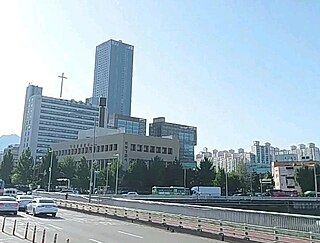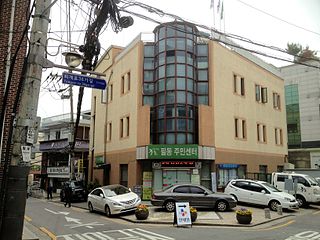
Busan, officially Busan Metropolitan City, is South Korea's second most populous city after Seoul, with a population of over 3.3 million inhabitants as of 2024. Formerly romanized as Pusan, it is the economic, cultural and educational center of southeastern South Korea, with its port being South Korea's busiest and the sixth-busiest in the world. The surrounding "Southeastern Maritime Industrial Region" is South Korea's largest industrial area. The large volumes of port traffic and urban population in excess of 1 million make Busan a Large-Port metropolis using the Southampton System of Port-City classification. As of 2019, Busan Port is the primary port in Korea and the world's sixth-largest container port.

South Korea is made up of 22 first-tier administrative divisions: 6 metropolitan cities, 1 special city, 1 special self-governing city, and 14 provinces, including three special self-governing provinces and five claimed by the ROK government. These are further subdivided into a variety of smaller entities, including cities, counties, districts, towns, townships, neighborhoods and villages.

Dongnae District is a gu (district) in central Busan, South Korea.

Geumjeong District is a district in north central Busan, South Korea. Approximately 7.3% of Busan's population is in Geumjeong District. The Hoedong Reservoir is located on the district's eastern boundary, and the mountain Geumjeongsan on the west. Because of this, 75% of the district's land is restricted from residential development. The district's population is concentrated in the valley of the Oncheoncheon stream, a tributary of the Suyeonggang.

Suyeong District (Korean: 수영구) is a district (gu) in central Busan, South Korea. It has a population density of about 17,768 inhabitants per square kilometer (46,020/sq mi).

Yeonje District is a gu in central Busan, South Korea. It has an area of 12.08 km2, and a population of about 220,000. Yeonje-gu was created in March 1995 following its separation from Dongnae-gu. Its name was formed by taking the first and last syllables of the names of its only 2 legal dong; Yeonsan-Dong and Geoje-Dong. Busan City Hall is located in Yeonje-gu.

Jangjeon is a dong, or precinct, in Geumjeong-gu, Busan, South Korea. A heavily populated district, it is located between the slopes of Geumjeongsan and the valley of the Oncheoncheon. It is bounded to the south by Oncheon-dong in Dongnae-gu and to the north by Guseo-dong. Due to its large population, Jangjeon-dong is divided into three "administrative dong," Jangjeon 1, 2, and 3-dong.
Yeonhui-dong (Korean: 연희동) is a dong (neighbourhood) at the center of Seodaemun-gu in Seoul, South Korea. It is an area in Seoul near Yonsei university, and actually the name Yonsei comes from the combination of Yeonhui and Severance.

Dobong District is one of the 25 districts of Seoul, South Korea. As of 2020, Dobong has a population of 315,979 and an area of 20.71 square kilometres (8.00 sq mi), and is divided into four administrative neighborhoods. The district is located in northeastern Seoul, bordering the Gyeonggi Province cities of Yangju and Uijeongbu to the north, and the districts of Gangbuk to the southwest and Nowon to the east.

Dongdaemun District is one of the 25 districts of Seoul, South Korea.

Samcheong-dong is a dong, neighbourhood of Jongno-gu in Seoul, South Korea. It lies north of Jongno and east of Gyeongbokgung. This hilly neighborhood is characterized by numerous small art galleries, shops, and restaurants. Visitors to the area can see restored hanok, Korean traditional-style houses. The Board of Audit and Inspection of Korea is located here. It is also home to several foreign government offices including the Vietnamese consulate.
Seorin-dong is a dong (neighbourhood) of Jongno-gu in Seoul, South Korea. It is a legal dong administered under its administrative dong, Jongno 1, 2, 3, 4 ga-dong.
Tongin-dong is a dong, neighbourhood of Jongno-gu in Seoul, South Korea. It is a legal dong administered under its administrative dong, Hyoja-dong.

Pil-dong is a dong, neighbourhood of Jung-gu in Seoul, South Korea.

Sindang-dong (Korean: 신당동) is a dong, neighbourhood of Jung-gu in Seoul, South Korea.

Seongsu-dong (Korean: 성수동) is a dong, or neighbourhood, of Seongdong District, Seoul, South Korea. It is further subdivided into Seongsu-dong 1-ga and Seongsu-dong 2-ga, and is served by Ttukseom Station and Seongsu Station on Seoul Subway Line 2 and by Seoul Forest Station on the Suin-Bundang Line. Its most notable attraction is Seoul Forest, a public park. The neighborhood has become popular in recent years for its array of cafes and restaurants, many of which have been set up in repurposed factories and old residential buildings, earning it the nickname "The Brooklyn of Seoul". There are also various stores built inside repurposed shipping containers.
Nagwon-dong is a dong, neighbourhood of Jongno-gu in Seoul, South Korea. Nagwon means "paradise" in Korean. It is a legal dong administered under its administrative dong, Jongno 1, 2, 3, 4 ga-dong.

Donghwa-dong is a dong (neighborhood) of Jung District, Seoul, South Korea.

Geumseong is a dong (neighborhood) in Geumjeong District, Busan, South Korea. A lightly populated district, it is situated entirely within the mountain range of Geumjeongsan. It is bounded to the west by Hwamyeong-dong and Geumgok-dong in Buk District, to the northwest by Dong-myeon of Yangsan City, to the east by Cheongnyong-dong, Namsan-dong, Guseo-dong, and Jangjeon-dong of Geumjeong District, and to the south by Oncheon-dong in Dongnae District. The northernmost point in Geumseong-dong is at Godang-bong, the highest peak in Geumjeongsan.
Allak is a dong in Dongnae District, Busan, South Korea. It is divided into two administrative dong, Allak 1-dong and Allak 2-dong. The total area is 2.31 km2, with a population of 18,560. It borders Geumjeong District on the north.














